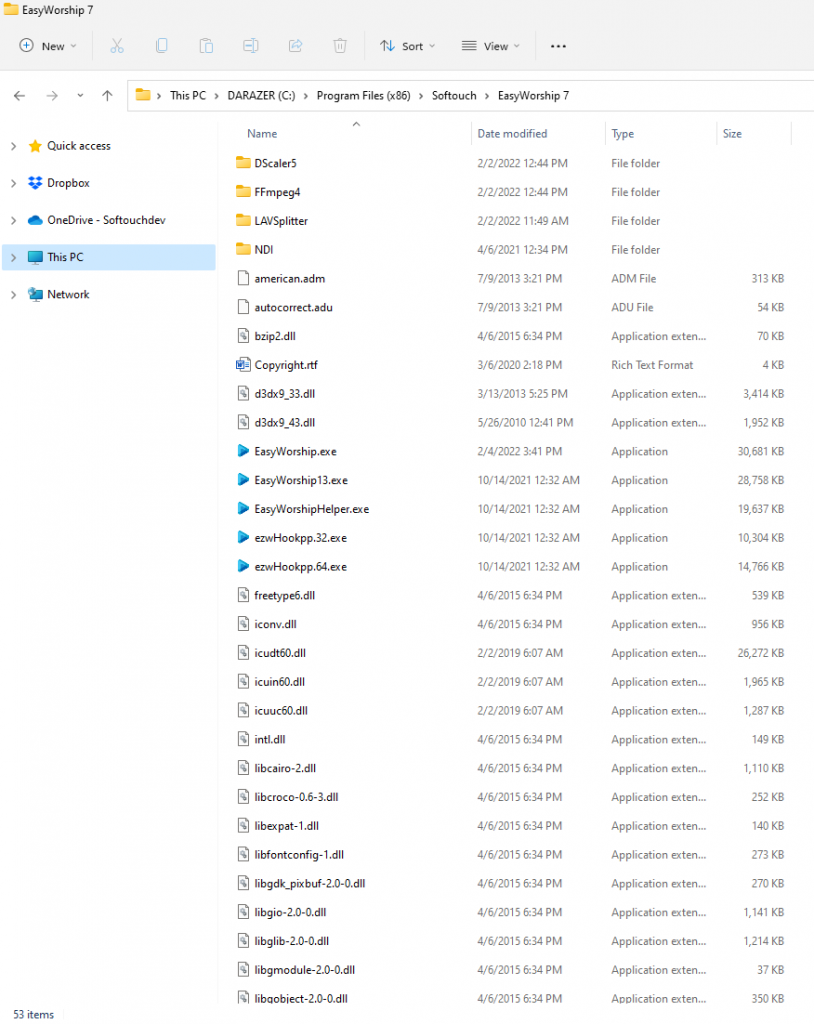All computer programs have a specific file structure. Normally, there will be a location on the computer for the program files themselves and another location (only if different than the program files) for the data files. Even though computer programs are written by different people, most of them generally follow a similar structure to make things easier for the end-users.
For the most part, EasyWorship follows a common structure, but there are some files that may be harder to find, especially if you don’t spend a lot of time searching around your computer for where files can be hidden.
EasyWorship stores its program files in the standard location. On your local hard drive, you’ll find a folder called Program Files (Program Files (x86) if you’re running a 64-bit Operating System). Inside that folder will be a folder called Softouch, then EasyWorship with the version number after it. There, you will find most of the files needed to run the actual EasyWorship program. There are some codec folders, executable files, and .dll files among a few others. If this folder ever gets renamed or deleted, opening EasyWorship from the icon on your desktop or from the Windows start menu will fail. But, if that ever happens, a simple reinstall will restore that folder to its entirety.

Another important location you want to know about is the Database and Resources location. These can be found by going to your local drive, then the Users folder, then Public, Public Documents, Softouch, and EasyWorship. Within the EasyWorship folder, you will find Profile folders. After you initially install EasyWorship and open it for the first time, it will create a profile called Default. In this EasyWorship folder you will see a profile folder called Default.

It contains the EasyWorship database, (the v6.1 folder), and all of your media files like images, videos, and presentations, (the Resources folder).

If your profile folder or any folder within it gets renamed or deleted, your EasyWorship program will still run, but it won’t be able to find your information. If it just gets renamed or moved to a different location on the computer or on the network, you can edit your profile in EasyWorship or create a new one and point it to the new location or the new folder name or just rename it back to what it originally was. If any of these folders get deleted, you could lose some or all your data, so it’s very important to make a frequent backup of it just in case something terrible happens.
There is a tool that can be downloaded and used to make a backup of your data files and to transfer them to another computer if needed. Below is a link to the download and instructions that walk you through how to do it step by step.
Transfer EasyWorship Profile : EasyWorship
Since your data files can be moved to a new location on the local drive or on a network drive, this means that your resources and database could be somewhere other than the default location. If that’s the case, you will need to find where that is and make note of it, and back it up from there. To find out where your database and resources are being accessed from, open EasyWorship and click on the Profiles menu and go to Profiles Manager. With your profile selected on the left, click the link in the middle of the window to take you to your profile location.

There are a few other files that you might also want to take note of that may not be in a very well-known location. The following files are in windows folders that are hidden by default; the ProgramData folder and AppData folder. Here, you can find files for EasyWorship that will allow you to reset how your EasyWorship windows show up on your screens, view and edit your EasyWorship hotkeys, and more. You can unhide these folders for windows, but there is an easy shortcut you can use to find them quickly.
Open a file explorer window and in the address bar type in %programdata% and press Enter.

Go to the Softouch folder and then EasyWorship.v7. There are a few different folders here you can look at, but the Settings folder will have the items that you may want to tweak. This is where you can find the ComputerSettings.ini and HotKeys.2.ini files.

For the AppData folder, open a file explorer window and in the address bar type in %appdata% and press Enter.

This will take you to the Roaming folder for your Windows user account. Go to the Softouch folder, then EasyWorship.v7. Open the Settings folder and you will find files like History.ini, UserSettings.ini, and WindowSettings.ini.

There are other locations EasyWorship will use to store files, like the Windows Registry, but the ones I mentioned above are the most common and really the only locations you will need to venture on your own. Knowing about these files and their locations will give you a little bit more control of how you use and tweak EasyWorship to work the best for you and your church.